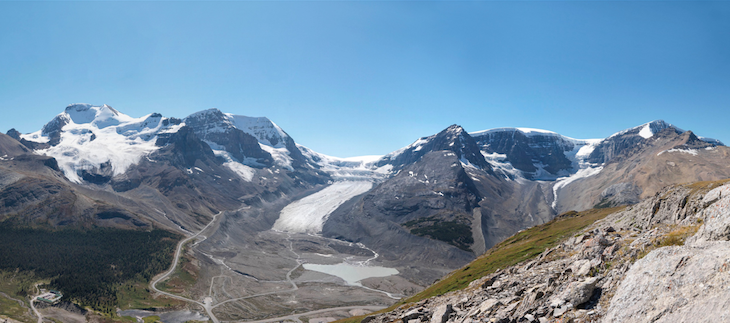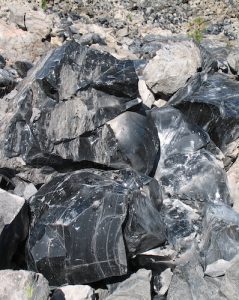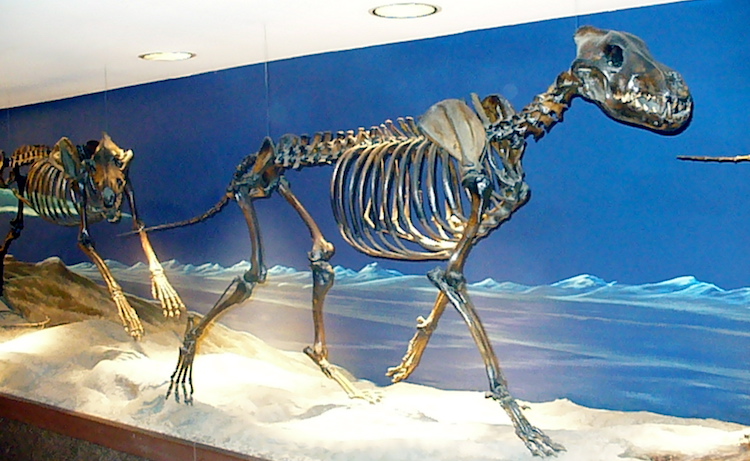Alina C. Fisher and Tanya Samman, Environmental and Earth Sciences co-editors
~SPOILER ALERT~
The TV show Game of Thrones ended with a bang on May 19, 2019 – or given the numerous criticisms of the finale, perhaps it would be more apt to say that it melted into a fiery heap like the Iron Throne. More than mere entertainment, science fiction and fantasy have often been used to explore current environmental or social issues. Game of Thronesoffers some fascinating parallels to issues we face today right here on Earth.
There are a few things that we can rule out as mere fantasy right away, like warging – the ability to transfer your consciousness into another living organism – or the existence of a magical necklace that bestows immortality. As much as we would love to control the actions of others or find the fountain of youth, we leave these to the minds of philosophers. However, there are some similarities between Westeros and Earth that give us pause.
Dragonglass/obsidian
Perhaps one of the most obvious similarities between our worlds is the existence of dragonglass (Westeros) and obsidian (Earth). Sam reveals early on in the series that the maesters (learned men), call dragonglass obsidian. Dragonglass is formed by dragon breath in common folklore, but the maesters distance themselves from that mysticism and believe it comes from the fires of the earth.
Obsidian is a volcanic rock that cools so quickly it has no time to form a distinct crystalline structure; this means that visible individual crystals of the component minerals do not develop during cooling. Instead, it is an amorphous/shapeless glass at both the macroscopic and microscopic levels. It is brittle and is best shaped into weapons by knapping, a process commonly used to create arrowheads and spearheads by ancient cultures across Canada – including the people of British Columbia, Saskatchewan, and Ontario. It’s not a metal, so it can’t be forged as it was on the TV show. Ultimately, dragonglass and obsidian are similar, but in Westeros it has some magical qualities, such as the ability to kill the undead white walkers, that it doesn’t have on Earth.
Dragons and dinosaurs
There is speculation that the bones of dinosaurs inspired stories of dragons, and certainly the similarity between the appearance of dinosaurs and dragons in Earth mythology is striking. In Westeros, dragons were once numerous but began to die in combat and become sickly under the care and ministrations of the Targaryens and maesters who tamed and kept them confined. Dragons were thought extinct by the time of the beginning of the first book in the A Song of Ice and Fire series. Throughout the course of the books, and the TV show, dragons are brought back into existence, but are left functionally extinct once again by the final episode with only one still alive. The parallels with species extinctions here on Earth are unmistakeable, and may prompt us to question the effectiveness of current conservation efforts. Whether we’re talking about burrowing owls, bison, or caribou, we should ask ourselves: “Will our efforts at reviving endangered species provide lasting results?”
Direwolves
Direwolves were considered rare in Westeros and became even rarer as the series progressed, as one after another lost their lives to chance and circumstance. Perhaps this is not too different from the extinction drivers of the North American dire wolf that ranged from Canada through to South America and was the largest known member of the genus Canis – although it was considerably smaller than its Westerosi counterpart. Whether it was directly caused by humans or due to a changing climate, dire wolves went extinct nearly 13,000 years ago. At the time of their extinction, the world of the dire wolf was warming up, much like our world is today. The climate of the direwolves of Westeros, on the other hand, is getting colder. As was stated often in Game of Thrones, “winter is coming.”
A song of changing climate
Whether the impending winter of Westeros is merely part of the regular climate cycle, or something less predictable,Game of Thrones makes us think about climate change here on Earth. Although the direction of climate change differs between Westeros and Earth, the changes in environmental conditions have similar effects. Under a changing climate, species must move to stay within their physiological tolerances, and we’re seeing that impact on plants, microbes, and animals on Earth. Some species like moose can walk around five kilometre per day, so they don’t face the same kinds of movement pressures that a sedentary species would. On Earth, individual trees can only “move” as dispersed seeds, unlike the Ents, tree-like characters in another fantasy series, The Lord of the Rings, who can pick up and walk where they want to go relatively quickly.
Cold- or alpine-adapted species face even more challenges. As the climate warms it creates smaller and smaller mountain-top islands where they can live – and larger spaces between these habitat oases. The loss of glaciers and treeline creep in the Rocky Mountains documented by the Mountain Legacy Project demonstrates the extent of this change on Earth.

The change in the extent of snow and ice cover in the Athabasca Glacier between 1917 and 2011. Photo: Library and Archives Canada/Bibliothèque et Archives Canada and The Mountain Legacy Project
Unfortunately, we lack the information to make a direct comparison with what is happening in Westeros in this regard. In general, however, these distances and other physical barriers can make dispersal impossible for some species, and greatly impede others. This can result in new combinations of species, with unknown impacts on ecological function, ecosystem services, or even on human health. For example, we’re finding that on Earth Lyme disease is spreading northward, much like Greyscale does in Game of Thrones. Either way, neither we nor the inhabitants of Westeros would be immune to the impacts of a changing climate.
Our watch has not ended
The TV series Game of Thrones has ended, and so we don’t know just how much change is yet to come as the deep winter of Westeros takes hold; perhaps the remaining books in the A Song of Ice and Fire series will shed some light on this. However, we can continue to watch the effects of climate change here on Earth, and wonder which species will be the ultimate winners and losers under climate change scenarios. Although the direction of climate change differs between Earth and Westeros, our people, wildlife, and environment face many of the same challenges.
~30~









I enjoyed your article Alina; you are a good writer!